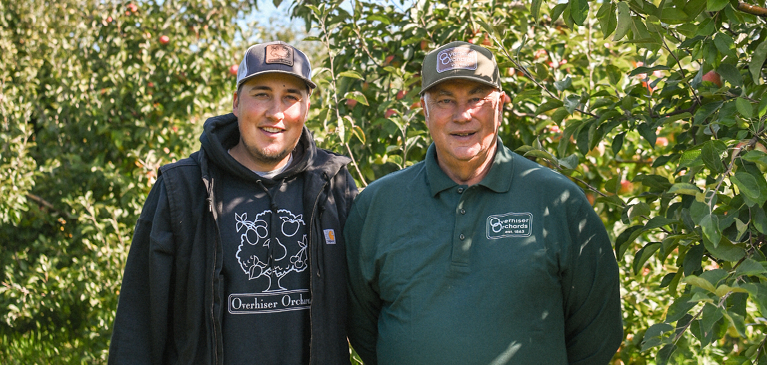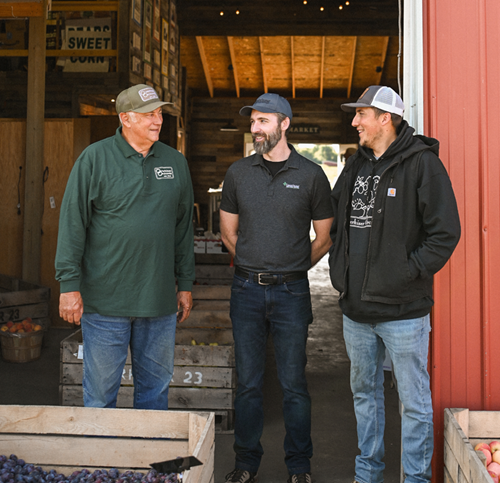
Family owned since its founding amid the American Civil War, Overhiser Orchards in South Haven, Mich., has been “providing fresh fruit since 1863.”
Allan Overhiser represents the fifth generation of his family to own and operate the farm.
Allan and his wife, Kim, welcomed their first son in 1996. Two years later they welcomed quadruplets. Alex Overhiser, one of the four, eventually joined his father as an owner of the operation – carrying the family legacy, and farm, into its sixth generation.
Situated about a mile from where the first South Haven peach – the predecessor of the lauded Red Haven variety – was discovered, Overhiser Orchards’ retail location features a barn-themed farm market stocked with fruit harvested on site and homemade apple cider donuts, as well as other produce and various locally sourced products. It also offers visitors the option to pick their own fruit, including a variety of sweet and sour cherries, peaches, pears, plums, and apples.
Agritourism makes up around half of Overhiser Orchards’ business today, according to Allan.
“We’re open from 10 a.m. to 5 p.m. every day – all holidays,” says Alex. “We try to have something for everyone. So, when they come out, they know there is something fresh for them to find.”
A commercial fruit operation makes up the other half of the orchard’s business.
“We have primarily one farm that’s dedicated to retail and U-pick. The rest of the acreage goes towards the normal commercial outlets,” Allan said. “We do a lot of what I call, ‘mom-and-pop wholesale.’ In other words, farm markets and different customers in Indiana for some of our peaches and plums and pears.”
Agriculture is notoriously unpredictable, and fruit is among its most unpredictable sectors. Sensitivity to subtle weather variables, high input costs, perishability, and price volatility are just a few of the factors that have made fruit farming a difficult business to sustain, let alone grow.
According to Allan, one key to Overhiser Orchards’ longevity has been its conscious effort to maintain diversity across the fruit it grows.
Not only does diversification expand the farm’s growing season and production capacity, spreading risk across multiple fruits helps to lower the impact of a bad crop on the operation.
However, crop diversification is a double-edged sword, Allan says. On one hand, growing many different crops allows the grower to lower the likelihood that their entire yield is impacted by a disaster. However, it also increases the likelihood that some of their crops will perform poorly year in and year out.
“Because we’re so diverse and have a lot of different crops, I always say, ‘We’re so diverse that we’re guaranteed a disaster in something every year,’” Allan quips.
Fruit crop insurance is the second key that Allan attributes to Overhiser Farms’ continued success.
“Crop insurance has been a real difference maker,” says Allan. “A lot of people would say, ‘Well, you’re so diverse, so you’re self-insured.’ But at the end of the day, the same types of disasters can affect all my crops in a single year every once in a while, and that’s tough.”
Recalling the decades that his family spent managing Overhiser Orchards before fruit crop insurance was available, Allan emphasized the night and day difference it has made.
“As a kid growing up in the 1960s and the 1970s, there were some really hard years in the fruit industry,” Allan recollects. “From overproduction to freezes, it was a tough go. A lot of farms went by the wayside.”
In addition to farming, both of Allan’s parents had other careers. His father, Albert, was a truck driver. His mother, June, was a schoolteacher. Without similar secondary employment, many of the elder Overhisers’ contemporaries during the mid-20th century saw their operations fail when inevitable bad years struck.
“Crop insurance is something they just didn’t have the option to purchase,” Allan laments. “I think life would have been a little easier for them if they could have had that.”
The Federal Crop Insurance Corporation was founded in 1938 in response to the Dust Bowl and the Great Depression, according to the U.S. Department of Agriculture.
In the 1980s the federal crop insurance program expanded coverage options to include more crops and larger swaths of the country. Over the next two decades, as a result of additional revisions to federal policies, the number of American farmers utilizing crop insurance had increased significantly. Overhiser Orchards was one of the many operations that began taking advantage of emerging crop insurance options in the 1990s.
According to Allan, crop insurance has not only provided more peace of mind in the face of the incredible year-to-year volatility of the fruit industry but allowed the operation the cushion and confidence required to expand its business rather than simply sustain it.
“Finding somebody that is invested in your operation as much as you can be difficult. Crop insurance can be a creative way to invest in other aspects of the farm as you grow,” says Jeffrey Sparks, the Overhiser’s GreenStone crop insurance specialist. “For the Overhisers, they used their commercial apples, peaches, and crop insurance to carry them as they slowly built out their direct markets. Having an agent that understands your operations and goals can help growers achieve their goals for future generations.”

The Overhiser's and their crop insurance agent, Jeffery Sparks
A practical benefit of fruit crop insurance, on which Allan places tremendous value, is its ability to support keeping on key employees, even during years when costly disasters hit.
“It was always tough before crop insurance. If you freezed out, you would board up the windows, try to maintain the trees, and do what you could do,” says Allan. “But with crop insurance, you can better keep the key employees that you need to continue the farm instead of having to tell them, ‘Sorry, guys. I don’t have any work for you this year.’”
“This is something that is often overlooked,” says Jeffrey. “Crop insurance doesn’t just provide revenue from the crop you are missing. It helps operations keep employees and stability into the future.”
Growing up by his father’s side, working on the farm in various capacities since he was a child, and now an owner looking to one day take over the family business, Alex recognizes the role crop insurance has played in providing him the opportunity to think outside the box and be creative with expanding Overhiser Orchards’ offerings and attractions.
“It’s been a privilege to watch Alex grow into his role on his farm,” said Jeffrey. “The joy and satisfaction it brings to me as an agent to watch one generation transition to another gives me a sense of pride that I was able to help that transition take place, even if I wasn’t the main component to that success!”
Just this year, Alex led the farm to invest in a children’s play area called “The Barnyard,” that features large, farm-themed bounce houses, games, and a bucket train powered by an ATV “locomotive.”
Such benefits are why Allan and Alex place such a high value on crop insurance and intend to keep it as a standard part of their business strategy indefinitely.
“Crop insurance is not cheap. It’s certainly something that you have to think about. You have to choose the right product for the right scenarios and make some financial decisions about what you purchase,” Allan said.
“But at the end of the day, I don’t think we’re going to turn a wheel without crop insurance.”
To view the rest of the 2025 fall Partners articles please click here.


